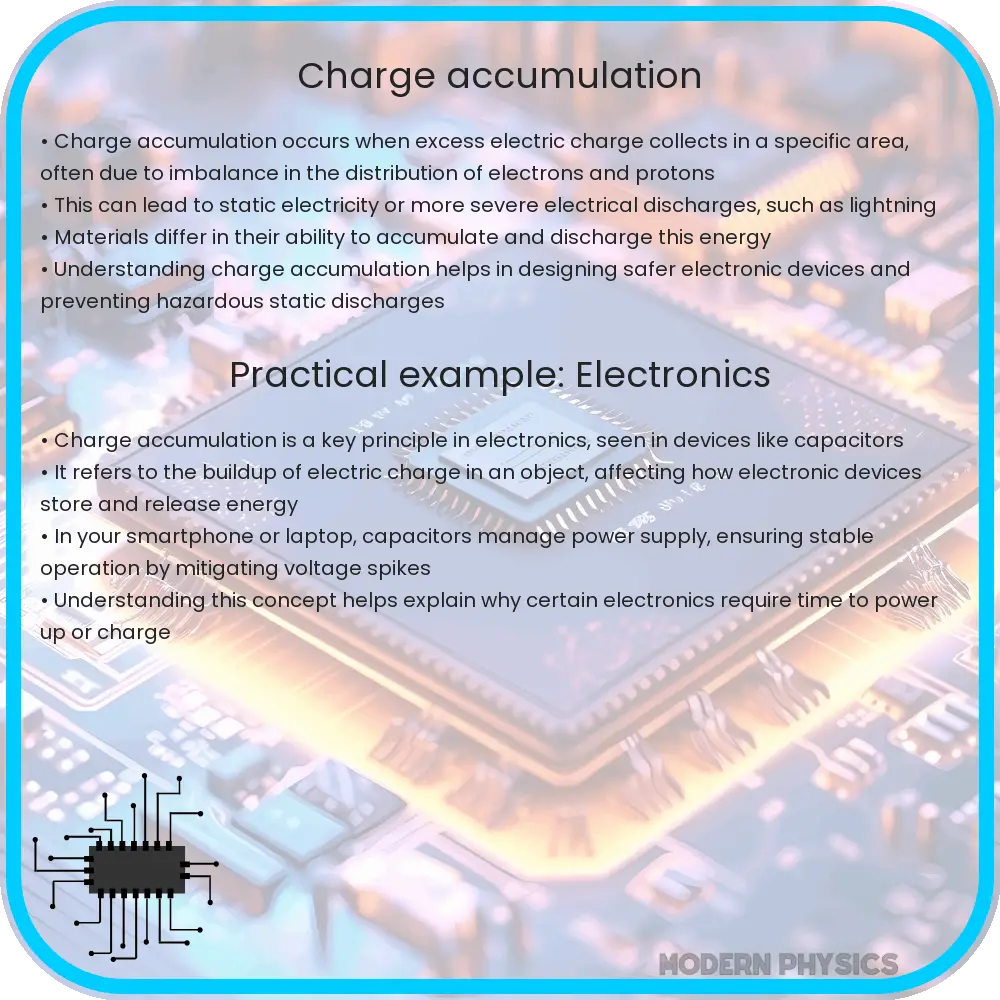Explore causes, effects, and prevention of charge accumulation in electrostatics, ensuring safety and efficiency in electronic environments.

Understanding Charge Accumulation in Electrostatics
Charge accumulation in electrostatics refers to the build-up of electric charges on the surface of materials. This phenomenon occurs when electrical charges, either positive or negative, collect in an area, often leading to an imbalance in the electric charge distribution. Understanding the causes, effects, and prevention methods is crucial in various industrial and scientific applications, particularly in fields dealing with sensitive electronic equipment.
Causes of Charge Accumulation
The primary causes of charge accumulation include:
- Friction: When two different materials come into contact and are then separated, electrons may transfer from one material to the other. This process, known as the triboelectric effect, leads to one material becoming positively charged and the other negatively charged.
- Conduction: Charge accumulation can also occur through direct contact between a charged and an uncharged object. The transfer of electrons results in both objects acquiring a net charge.
- Induction: In induction, a charged object brought near a neutral object causes a redistribution of charges within the neutral object, leading to a separation of charges without direct contact.
Effects of Charge Accumulation
While charge accumulation is a natural phenomenon, it can have various adverse effects, especially in sensitive environments:
- Electrostatic Discharge (ESD): The sudden flow of electricity between two electrically charged objects caused by contact can damage electronic components, ignite flammable mixtures, and even cause system failures.
- Material Damage: Long-term exposure to accumulated charge can degrade materials, particularly those used in electronic devices.
- Interference with Electronic Equipment: Accumulated static electricity can interfere with the normal operation of electronic equipment, leading to malfunctions and data corruption.
Prevention of Charge Accumulation
To mitigate the risks associated with charge accumulation, several prevention strategies can be employed:
- Humidity Control: Maintaining a certain level of humidity in the environment can prevent the build-up of static charges, as moisture in the air helps dissipate electric charges.
- Anti-static Materials: Using materials that do not easily accumulate static charges, such as conductive or dissipative materials, helps in reducing the risk of charge accumulation.
- Grounding: Grounding objects and personnel in sensitive environments ensures that any accumulated charge is safely discharged to the earth, preventing the build-up of static electricity.
Advanced Prevention Techniques
In addition to basic strategies, there are advanced techniques to further mitigate the risks associated with charge accumulation:
- Ionization: Devices like ionizers neutralize static charges in the air, making them particularly effective in environments where traditional grounding is not feasible.
- Static Dissipative Coatings: Applying coatings that dissipate static electricity on surfaces prone to charge accumulation can significantly reduce the risk.
- Regular Maintenance and Monitoring: Regularly inspecting and maintaining electronic equipment and grounding systems ensures they are functioning properly and effectively minimizing static build-up.
Impact on Safety and Productivity
Implementing these prevention measures not only safeguards sensitive electronic equipment but also enhances workplace safety and productivity. In environments like semiconductor manufacturing or chemical processing plants, where the effects of static discharge can be catastrophic, such preventive measures are indispensable. Moreover, minimizing electrostatic interference in electronic devices ensures reliability and longevity, which is crucial in today’s technology-driven world.
Conclusion
Charge accumulation in electrostatics, while a naturally occurring phenomenon, poses significant challenges in various industrial and scientific domains. Understanding its causes, effects, and the various strategies for its prevention and mitigation is essential. From simple practices like maintaining adequate humidity levels to employing sophisticated ionization techniques, the approaches to managing static electricity are diverse. By implementing these measures, we can protect sensitive electronic equipment, ensure the safety of work environments, and enhance the reliability and efficiency of technological processes. Embracing these practices not only addresses immediate safety and operational concerns but also contributes to the advancement and sustainability of industries reliant on electronic technology.
